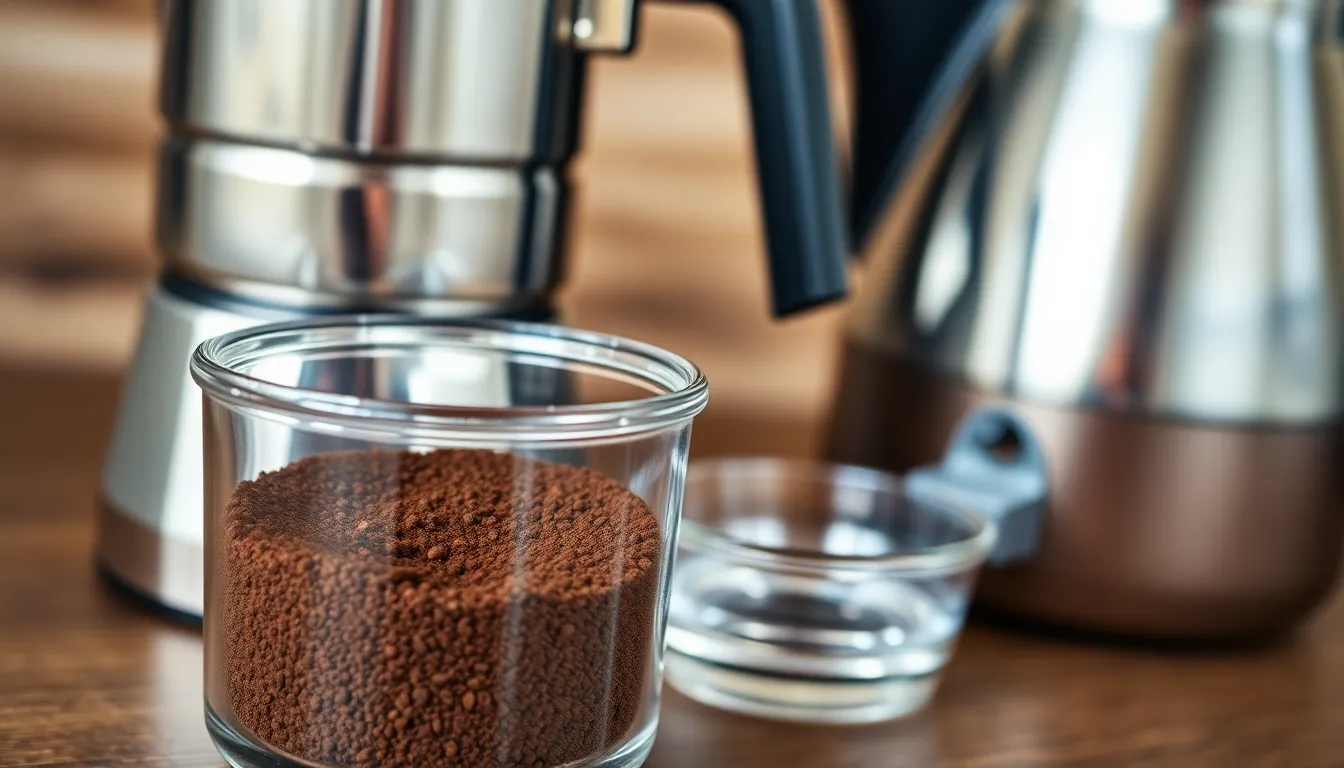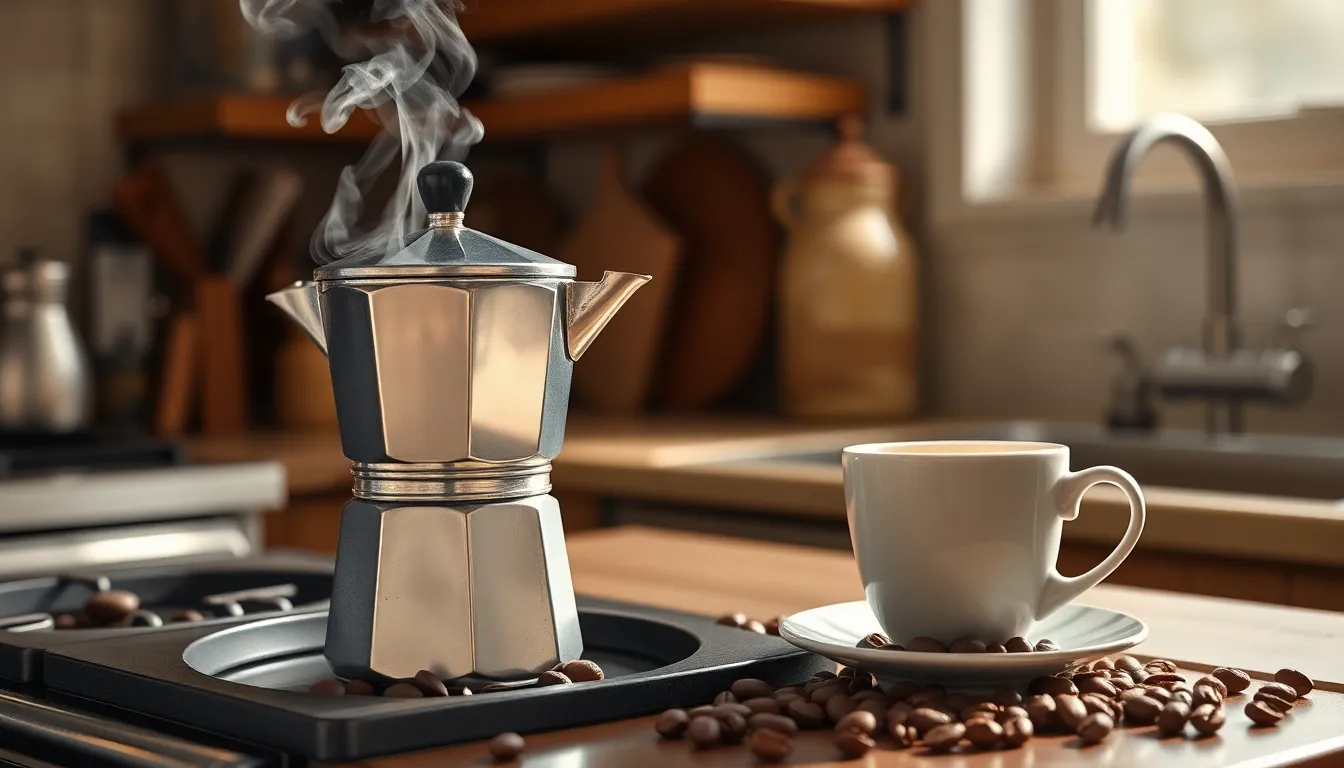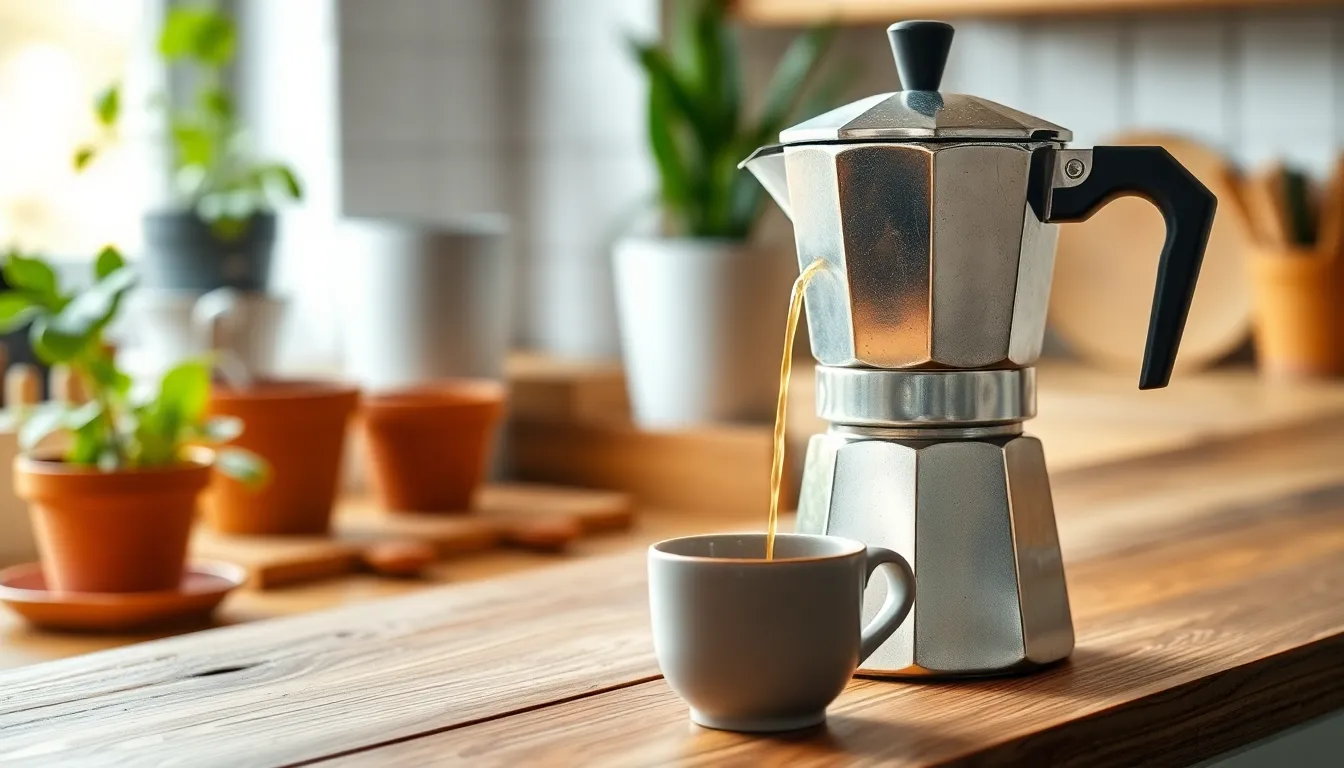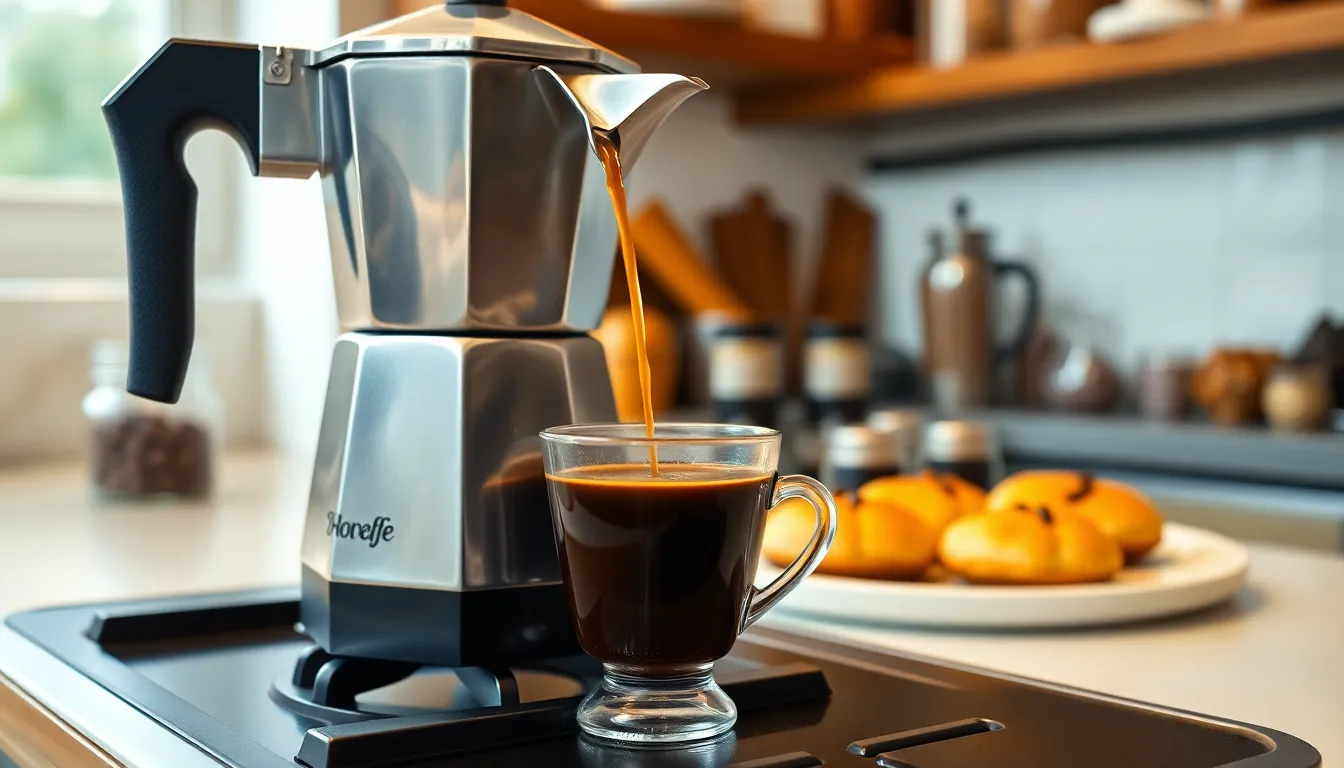Are you ready to elevate your morning coffee ritual with delicious moka pot recipes? This iconic stovetop brewer creates rich, espresso-like coffee that serves as the perfect base for countless creative concoctions.
From classic Italian-inspired drinks to innovative flavor combinations, your moka pot is more versatile than you might think. Whether you’re a coffee aficionado looking to experiment or a busy professional seeking quick caffeine fixes, these recipes will transform your humble moka pot brew into café-quality beverages right in your kitchen. Let’s explore how this simple brewing method can unlock a industry of coffee possibilities.
What Makes Moka Pot Coffee Special
Moka pot coffee stands out from other brewing methods with its distinctive character and rich heritage. The unique pressure brewing system creates a concentrated coffee with bold flavors that sits between drip coffee and espresso in strength. This Italian-designed brewer extracts deeper notes from your beans, producing a robust cup with a velvety mouthfeel that’s impossible to replicate with standard brewing methods.
The characteristic pressure-brewing process generates around 1.5 bars of pressure—less than commercial espresso machines but enough to extract intense flavors and subtle oils from your coffee grounds. Many coffee enthusiasts appreciate the tactile experience of preparing coffee in a moka pot, from the ritual of filling the chambers to the distinctive gurgling sound signaling coffee is ready.
“I’ve been brewing with my moka pot for over 15 years, and there’s something magical about watching that first dark stream of coffee emerge,” shares Rikki Manny. “The aroma fills my kitchen every morning with a richness that just isn’t there with other brewing methods.”
Temperature control plays a crucial role in moka pot brewing success. The aluminum or stainless steel construction conducts heat efficiently, while the octagonal design helps distribute heat evenly for consistent extraction. These engineering elements contribute to the concentrated flavor profile that makes moka pot coffee perfect as a base for various specialty coffee drinks.
Unlike electric coffee makers, moka pots don’t require filters, resulting in a more environmentally friendly brewing method that allows more coffee oils to remain in your final cup. These natural oils create that distinctive crema-like foam on top—a hallmark of quality moka pot coffee that enhances both flavor and visual appeal in your finished beverages.
Essential Equipment for Perfect Moka Pot Brewing

Brewing exceptional moka pot coffee requires exact equipment and attention to detail. Your choice of tools directly impacts the flavor, richness, and overall quality of your brew.
The Right Grind Size
Finding the perfect grind consistency is crucial for moka pot success. Your coffee should be ground medium-fine—coarser than espresso but finer than drip coffee—to create the ideal extraction environment. This exact grind size allows water to flow through the coffee bed properly without causing clogging or excessive bitterness. Consistency in your grind ensures uniform extraction throughout the brewing process, directly affecting taste balance and mouthfeel. Many coffee enthusiasts invest in quality burr grinders to maintain precise particle size control, as blade grinders often produce inconsistent results that lead to uneven extraction and flavor issues.
Water Quality Considerations
Water quality fundamentally shapes your moka pot coffee experience since coffee is 98% water. Filtered or distilled water supplemented with balanced minerals produces cleaner, more flavorful results than untreated tap water. Chlorine, excessive minerals, and other impurities commonly found in tap water can introduce unwanted flavors and mask the coffee’s natural notes. Fill your boiler chamber precisely to the bottom edge of the safety valve—this exact measurement creates the optimal 2-3 bars of pressure needed for proper extraction. Using pre-heated water in the chamber reduces the time your moka pot spends on heat, minimizing the risk of developing bitter, burnt flavors that occur when grounds are exposed to prolonged heating. The temperature sweet spot lies between 195-205°F (90-96°C), hot enough to extract desirable compounds but not so hot that it scorches the coffee.
Classic Moka Pot Coffee Recipe

The classic moka pot recipe delivers a rich, robust coffee that sits between drip coffee and espresso in strength. This traditional Italian brewing method requires precise measurements and technique to achieve the perfect cup.
Step-by-Step Brewing Guide
- Preheat water in a kettle to just below boiling temperature.
- Fill the bottom chamber of your moka pot with hot water up to the safety valve level.
- Insert the filter basket and add about 1½ tablespoons (15g) of coffee per 6 fl oz (180ml) of water.
- Level the grounds without pressing them down – compression impedes proper extraction.
- Screw the top chamber tightly onto the base, ensuring the rubber gasket is properly positioned.
- Place the moka pot on low to medium heat on your stove.
- Watch for coffee to emerge from the central spout, which typically takes 5-10 minutes.
- Remove from heat when the coffee stream changes from dark to a lighter “blonding” color.
- Serve immediately for optimal flavor and aroma.
Common Mistakes to Avoid
Using cold water directly in the moka pot leads to overheating and burnt coffee flavors. The extended time on heat causes the grounds to scorch before proper extraction occurs.
Overfilling the water chamber past the safety valve creates dangerous pressure buildup. This safety risk compromises both your brewing experience and potentially damages your pot.
Grinding too fine or compressing the coffee grounds in the filter basket restricts water flow. This blockage results in bitter coffee or prevents brewing altogether.
Applying excessive heat causes rapid boiling and burnt, metallic flavors. Gentle, steady heat extraction preserves the coffee’s complex taste profile.
Neglecting regular cleaning of your moka pot allows coffee oils to build up. These residual oils turn rancid over time, contaminating future brews with off-flavors.
Leaving the pot on heat after the coffee has fully brewed extracts harsh compounds. The ideal time to remove from heat is precisely when the stream lightens, preventing those final bitter notes from entering your cup.
Creative Moka Pot Coffee Variations

The moka pot’s versatility extends far beyond a standard cup of coffee. Explore these innovative recipes to transform your everyday brew into exciting coffee experiences that rival specialty cafés without expensive equipment.
Moka Pot Cappuccino
Creating a cappuccino with a moka pot offers an accessible way to enjoy this beloved Italian classic at home. Begin by brewing a strong moka coffee base using the traditional method. Heat milk separately in a small saucepan until steam appears but before it boils. Froth the milk using a French press by pouring the warm milk inside and vigorously moving the plunger up and down, or use a dedicated milk frother for more consistent results. Pour your freshly brewed moka coffee into your favorite cup, then add the steamed milk and top with a generous layer of milk froth. This homemade cappuccino delivers rich flavor and satisfying texture without requiring an expensive espresso machine, making it perfect for morning indulgences or afternoon pick-me-ups.
Spiced Moka Coffee
Infusing your moka pot coffee with aromatic spices creates warming, complex flavors perfect for cozy mornings or special occasions. Add ground spices such as cinnamon, cardamom, or nutmeg directly to your coffee grounds before brewing, allowing the pressurized water to extract both coffee and spice flavors simultaneously. Alternatively, stir spices into your freshly brewed coffee for a more controlled intensity. Cuban coffee techniques inspire another variation where sugar is creamed directly into the first drops of coffee, creating a sweet paste that’s incorporated into the remaining brew for caramel-like notes. Experimenting with vanilla, star anise, or even a pinch of chili powder opens up endless possibilities for customized spiced coffee that matches your taste preferences and complements seasonal moments.
Cold Brew Moka Adaptation
Transform your hot moka pot brew into refreshing cold coffee perfect for warm weather enjoyment. The quickest method involves brewing coffee normally then immediately pouring it over ice to flash-cool it, preserving the robust moka pot flavors in a chilled form. Remember to brew slightly stronger than usual since the ice will dilute the coffee as it melts. For a smoother experience, brew your moka coffee, allow it to cool to room temperature, then refrigerate for several hours before serving over fresh ice with optional milk or sweetener. Adding 20g of vermouth and 10g of soft grappa to your chilled moka coffee creates an elegant, aromatic twist with floral and fruity notes that’s perfect for afternoon refreshment. These cold adaptations maintain the moka pot’s characteristic richness while delivering it in a format ideal for summer days or year-round iced coffee cravings.
Pairing Foods with Your Moka Pot Coffee

Moka pot coffee delivers a rich, concentrated flavor profile with distinctive body and character that makes it particularly well-suited for food pairings. The dense, viscous texture and robust taste create opportunities for complementary or contrasting food combinations that enhance your coffee experience.
Sweet Pairings
Pastries with buttery textures like flaky croissants match perfectly with moka pot coffee’s intensity. Traditional Italian biscotti, designed specifically for coffee dipping, absorbs the rich coffee while maintaining its structure. Almond cookies provide a nutty sweetness that balances the coffee’s natural bitterness without overwhelming it.
Caramel desserts harmonize beautifully with moka pot coffee, as the caramelized sugar notes complement similar flavor compounds present in the brew. Chocolate-based treats, especially dark chocolate varieties, create an indulgent pairing that intensifies both flavors. Fruit tarts featuring berries or stone fruits contribute brightness that cuts through the coffee’s richness.
Savory Options
Cheese selections offer surprising compatibility with moka pot coffee. Aged varieties like Parmigiano-Reggiano or Gouda develop nutty, caramel notes that mirror coffee’s complex profile. Cured meats such as prosciutto or salami provide a salty contrast that enhances the coffee’s sweetness. Lightly spiced dishes featuring cinnamon, cardamom, or nutmeg create aromatic bridges between food and beverage.
Regional Pairings
Cuban coffee made in a moka pot pairs exceptionally well with traditional Cuban pastries. Pastelitos filled with guava or cheese deliver sweet-savory contrasts that complement the intense, sweetened coffee. Sweet breads like pan de gloria or media noche sandwiches create authentic cultural combinations that respect coffee traditions.
Mediterranean-inspired pairings work beautifully with Italian-style moka pot preparations. Cannoli with ricotta filling or amaretti cookies honor the moka pot’s Italian heritage. Light breakfast items like frittatas or olive bread toast points provide substantial but not overwhelming companions to morning brews.
Troubleshooting Your Moka Pot Brew

Even experienced moka pot users encounter brewing challenges occasionally. Identifying common issues and implementing simple fixes ensures your coffee consistently achieves that perfect balance of richness and flavor. Follow these expert tips to resolve typical moka pot problems and elevate your brewing experience.
Dealing with Weak Coffee
Weak coffee often results from incorrect grind size or insufficient coffee in the filter basket. Use a medium-fine grind similar to pour-over V60 consistency for optimal extraction. Fill the filter basket completely with approximately 20g of coffee, distributing it evenly without tamping too firmly. Ensure your water reaches the appropriate temperature—using pre-heated water around 195-205°F (90-96°C) creates proper brewing pressure and extracts coffee efficiently.
Preventing Bitter Flavors
Bitterness typically stems from over-extraction during the brewing process. Remove your moka pot from heat immediately when coffee stops flowing into the upper chamber—about 10 seconds after coffee begins to appear. Leaving the pot on heat too long forces additional hot water through already extracted grounds, creating unpleasant bitter notes. Starting with hot water in the bottom chamber speeds up brewing time and reduces the risk of coffee overheating during preparation.
Fixing Leaks and Pressure Problems
Leaks between chambers indicate either improper assembly or unsuitable grind size. Coffee ground too finely can block water flow and create excess pressure, forcing water to escape between the bottom and top chambers. Coarsen your grind slightly if you notice this occurring. Check that all parts fit together properly, with the rubber gasket positioned correctly and free from coffee residue. Tighten the chambers firmly but avoid over-tightening, which can damage the gasket over time.
Addressing Metallic Taste
Coffee left sitting in an aluminum moka pot often develops a metallic taste. Serve your brewed coffee immediately after preparation for best flavor. Transfer leftover coffee to a separate container rather than keeping it in the pot. Regular cleaning also prevents metallic flavors—disassemble your moka pot completely after each use, rinse with hot water, and dry thoroughly. Avoid using soap or harsh cleaners that can leave residue affecting future brews.
Managing Uneven Extraction
Uneven extraction creates inconsistent flavor profiles in your coffee. Distribute grounds evenly in the filter basket without creating channels or gaps where water might flow through too quickly. Heating your moka pot at medium temperature promotes steady, controlled brewing. Too much heat causes rapid extraction in some areas while leaving others under-extracted. Using a flame spreader with gas stoves ensures even heat distribution across the bottom chamber for balanced extraction.
Conclusion
Your moka pot is more than just a coffee maker – it’s a gateway to a industry of rich coffee experiences. From classic Italian preparations to innovative flavor combinations this humble brewer delivers exceptional results when used correctly.
Armed with the right techniques proper equipment and creative recipes you’ll transform your daily coffee ritual into something truly special. Whether you’re enjoying a traditional brew with biscotti or experimenting with cold preparations and exotic spices the possibilities are endless.
Remember that perfecting your moka pot technique takes practice but the reward is worth it: a distinctive cup with character and depth that commercial coffee shops simply can’t match. Embrace this brewing tradition and make it your own.
Frequently Asked Questions
What makes moka pot coffee different from other brewing methods?
Moka pot coffee sits between drip coffee and espresso in strength. Its unique pressure brewing system creates a concentrated coffee with bold flavors and a velvety mouthfeel. Unlike other methods, the moka pot doesn’t use paper filters, preserving the coffee’s natural oils and creating a crema-like foam that enhances both flavor and presentation.
What grind size should I use for a moka pot?
Use a medium-fine grind for moka pot brewing. This consistency ensures optimal extraction without clogging the filter or creating too much resistance. The grind should be finer than what you’d use for drip coffee but coarser than espresso. Using a quality burr grinder helps maintain consistency for the best results.
How do I prevent bitter coffee from my moka pot?
To prevent bitterness, use pre-heated water in the chamber, remove from heat as soon as brewing is complete, and serve immediately. Avoid using water that’s too hot, overfilling the chamber, or leaving the pot on the heat after brewing is finished. Regular cleaning also prevents old coffee oils from affecting flavor.
Can I make cappuccino with a moka pot?
Yes! Brew a strong moka pot coffee as your base, then heat and froth milk separately. Pour the frothed milk over your coffee, creating a ratio of about 1:2 (coffee to milk). While not identical to machine-made cappuccinos, this method creates a satisfying alternative without an expensive espresso machine.
How do I clean and maintain my moka pot?
Rinse your moka pot with hot water after each use and allow it to dry completely. Avoid using soap on aluminum moka pots as it can affect flavor. Periodically disassemble and clean all parts, including the filter and rubber gasket. Replace the gasket annually or when it shows signs of wear to prevent leaks.
Why is my moka pot leaking during brewing?
Leaks typically occur due to improper assembly, a worn gasket, or overfilling. Ensure all parts are clean, the gasket is in good condition, and the chambers are properly aligned and securely screwed together. Never fill water above the safety valve, and check that coffee grounds aren’t obstructing the filter plate.
What foods pair best with moka pot coffee?
Moka pot coffee pairs beautifully with buttery pastries, biscotti, dark chocolate, and caramel desserts that complement its intensity. For savory options, try aged cheeses, cured meats, or lightly spiced dishes. Regional pairings like Cuban pastries with Cuban-style moka coffee also enhance the cultural coffee experience.
Can I make iced coffee with a moka pot?
Absolutely! Brew your moka pot coffee as usual, then cool it completely before pouring over ice. For best results, brew slightly stronger to account for dilution from ice. You can also create sophisticated cold coffee drinks by adding ingredients like simple syrup, vermouth, or even a splash of grappa.

